|
A Quick
Biology Lesson
In general, mold and mildew are different names
for the same thing a very simple life form that lacks the ability to
photosynthesize. Mold uses enzymes to digest nutrients from other organic
materials such your collections. Essentially mold consists of fungi that grow
in filamentous forms. Many fluoresce under UV light often helping to verify
their presence.
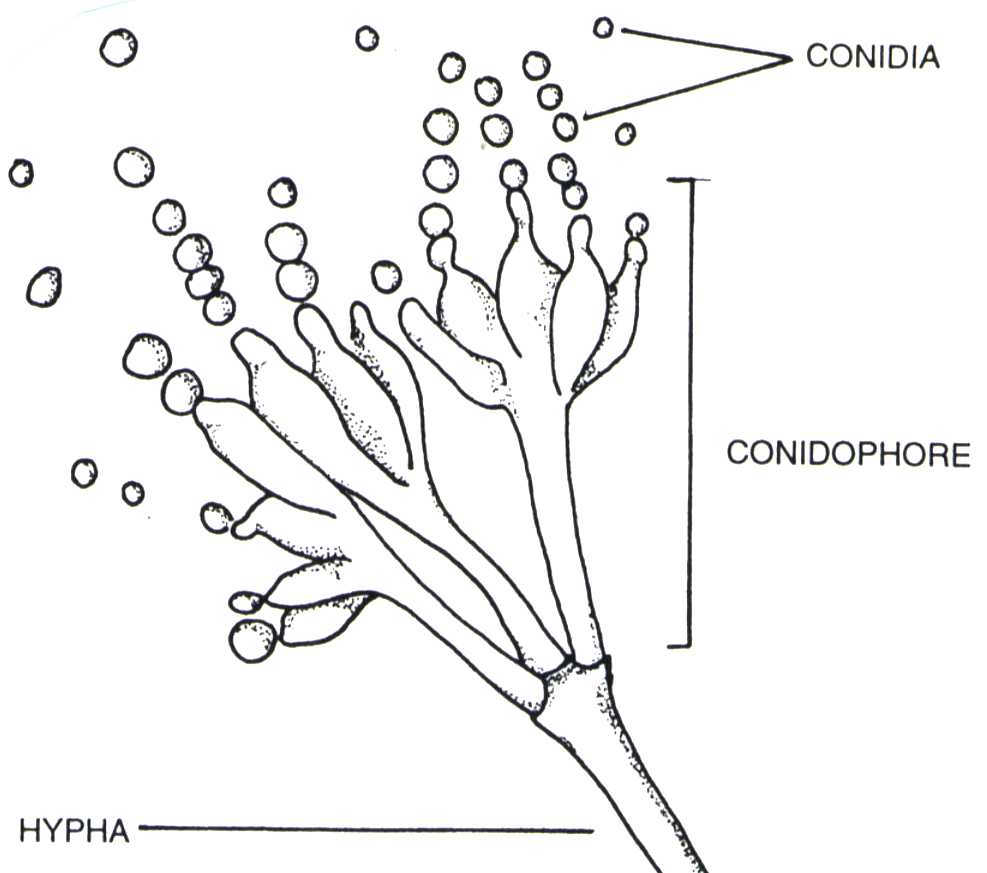 The
two most common "problem" molds for preservations are the Ascomycetes and Fungi
Imperfecti. The Ascomycetes include over 29,000 species, many of which are
disease causing. The Fungi Imperfecti is the second largest subdivision,
containing over 17,000 species and they are also very aggressive agents of
biodeterioration. The
two most common "problem" molds for preservations are the Ascomycetes and Fungi
Imperfecti. The Ascomycetes include over 29,000 species, many of which are
disease causing. The Fungi Imperfecti is the second largest subdivision,
containing over 17,000 species and they are also very aggressive agents of
biodeterioration.
The molds that we are most commonly concerned with reproduce through asexual
means, forming what are called conidia, although they are often called "spores."
Conidia are typically 5 to 50 m in diameter (Aspergillus fumigatus conidia are
among the smallest, measuring about 2.5 m) and are very easily air borne.
Each vegetative filament of fungus is called a hypha and a large mass of hyphae
is called a mycelium. These hyphae are the actively growing, assimilative phase
of the fungi and new growth typically occurs as a linear elongation of the
hyphae.
Molds often appear as circular spots, resulting from the outward growth of
hyphae. As the mold spreads, it begins to look more like a solid mat across
objects. It is important to understand that just as mold grows outward, it also
grows down, into the substrate, of the books, bindings, paper, and leather.
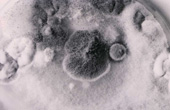 Molds
are everywhere and should not be viewed as a sudden "infection." The majority of
fungal conidia in the indoor environmental come from the outdoors. Consequently,
the most common molds are Cladosporium and Alternaria, with lesser
quantities of Aspergillus and Penicillium. The number of conidia
may reach one million per cubic meter under favorable conditions, although
levels of 10,000 to 100,000 per mģ are more common. Molds
are everywhere and should not be viewed as a sudden "infection." The majority of
fungal conidia in the indoor environmental come from the outdoors. Consequently,
the most common molds are Cladosporium and Alternaria, with lesser
quantities of Aspergillus and Penicillium. The number of conidia
may reach one million per cubic meter under favorable conditions, although
levels of 10,000 to 100,000 per mģ are more common.
Aureobasidium are stain fungi, commonly causing staining of wood
finishes. Mucor and Penicillium are examples frequently associated
with stone, producing acids which result in solubilization of silicates and the
weathering of stone. Aspergillus, Penicillium, Cladosporium, Fusarium,
and Paecilomyces are often associated with the discoloration of paint.
Fungi such as Aspergillus and Penicillium are often found colonizing
adhesives and caulks, with Penicillium in particular found associated
with PVC, plastic, and rubber. Aspergillus is associated with surface
discolorations of polyesters. Carpets are frequently attacked by Penicillium,
Aspergillus, Cladosporium, and Mucor. Library collections under damp
conditions are frequently infested with Penicillium, Fusarium, Aspergillus,
and Cladosporium.
What
Favors Mold?
Molds thrive in a wide range of environmental
conditions. Often there is a reference to the need for relative humidities to be
at or over 65% for mold to live. Some sources even claim that levels over 70%
are necessary. In spite of this, mold can be found aggressively growing at
much lower relative humidities.
Sometimes this can be explained by the concept of "water activity," abbreviated
aw. This is the surface equilibrium relative humidity of objects which can be
dramatically higher or lower than the ambient relative humidities. Other times
mold can be explained by inappropriate HVAC design, inadequate dehumidification,
poor building design, a failure to ventilate, unsuitable mixing of the supply
air, or a failure to adequately maintain the building envelope.
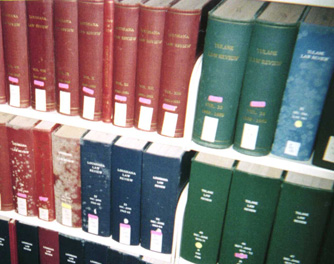 Molds
also thrive on our failure to practice good housekeeping. Typical vacuum
cleaning results in a 17-fold increase in mold conidia numbers and leaves these
numbers elevated for at least an hour afterwards. One study found that
disturbing a surface mold can cause a 3,300 times increase in airborne fungi
with 0.3 meter of the source. In libraries molds often gain a foothold in the
dust that accumulates on headcaps. Molds
also thrive on our failure to practice good housekeeping. Typical vacuum
cleaning results in a 17-fold increase in mold conidia numbers and leaves these
numbers elevated for at least an hour afterwards. One study found that
disturbing a surface mold can cause a 3,300 times increase in airborne fungi
with 0.3 meter of the source. In libraries molds often gain a foothold in the
dust that accumulates on headcaps.
Health
Effects of Mold
Inhalation of airborne microorganisms and their
metabolites may cause a wide range of respiratory problems and symptoms.
Mucous membrane irritation, coupled with a dry cough and eye irritation, are
common responses to continuous exposure. Bronchitis and chronic pulmonary
disease, while typically associated with smoking, may also be related to such
allergic reactions, although the role of airborne microorganisms hasn't been
determined. Allergic rhinitis and asthma, particularly among those who are
constitutionally predisposed to allergies, is perhaps one of the most severe
responses to mold exposure.
Even more potentially toxic are mold glucans constituents of fungal cell walls
which can cause immune reactions, resulting in mucous membrane irritation,
headache, muscular pain, cough, and chest tightness. Mycotoxins are poisonous
secondary metabolites of fungi, chiefly produced by Fusarium,
Penicillium, and Aspergillus all of which are common to buildings
and collections. Toxicity by inhalation can be 40 times greater than by
ingestion.
Although health experts, HVAC engineers, and industrial hygienists all agree
that mold isn't a good thing to have around, there aren't clear indoor limits.
John Lacey sums up the current issues regarding air quality standards:
There are many problems to setting standards for air quality in buildings: not
all organisms are equally allergenic or harmful to health; constitutional
predisposition to allergy in the exposed person may be more important than the
concentration of spores to which they are exposed; numbers out of doors
frequently exceed those indoors although the species differ; occurrence of
specific microorganisms indoors may indicate a constructional problem but not
necessarily a health hazard; the hazards of some microbial products are, at
present, little understood.
He notes considerable range in the guidelines proposed in the literature one
author, for example, suggests the recommended indoor limit should be set at
one-third of the outdoor level, with the same species spectrum but none are
directly applicable to a museum, library, or archive setting. The accompanying
table reveals comparative mold levels for indoor and outdoor air.
| Microbe |
Lower
Limit CFU/mē |
Average
Range Low |
Average
Range High |
Upper
Limit |
Inside/Outside Ratio - High |
Inside/Outside Ration - Low |
References |
| Indoor Fungal Spores |
50 |
10 |
500 |
150 |
0.1 |
0.33 |
American Conference of
Government Industrial Hygienists |
| Indoor Fungal Spores |
|
|
|
500 |
|
|
Canadian Guidelines |
| Outdoor Fungal Spores |
100 |
100 |
1000 |
|
|
|
California Healthy
Buildings Study |
The First
Step in Dealing With Mold
The first step in dealing with mold is to
identify and correct its cause. There is never any sense in cleaning up the
mold until you have dealt with the root cause.
Sometimes the mold is associated with disaster situations a leaking roof or
exploding toilet, for example. Dealing with such cases is easy: you repair the
roof or fix the plumbing. Sometimes the problem is chronic. For example, a roof
that always leaks, but no one can find the cause. Usually this means no one
wants to invest the time or money in finding the cause. You will need to
convince them of the value of the collection, the risk to the collection, their
responsibility to safeguard the materials.
Until the problem is resolved, you may need to drape collections (ranges of
books, banks of map cases, display cases) with clear poly sheeting, to deflect
the water leaks. If this is necessary, you must be especially careful since the
microenvironment under these drapes can be perfect for mold, even if there is no
"free" water. One device that helps collect and channel water is made by Croton
Products (732-560-9223). It is important to increase ventilation, which will
usually mean using supplemental fans in order to keep the air moving. Be sure
such fans meet local fire codes and are designed for continuous operation. Good
choices are industrial quality high volume fans.
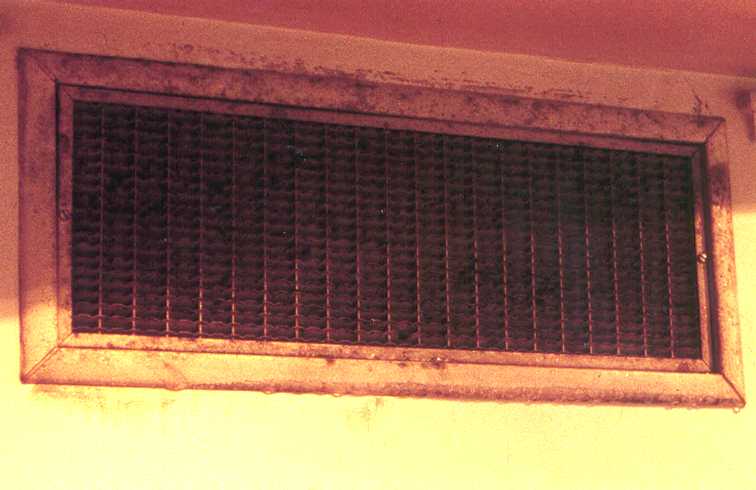 Sometimes,
however, the cause of the mold is more complex. Often the HVAC system for the
building was never designed to maintain a steady relative humidity. The system
was designed to deal with what is called sensible (temperature related) heat,
but not latent (moisture content) heat. Such systems may adequately cool your
building, but they do little or nothing to reduce the quantity of water in the
air (the absolute relative humidity). Without this capability such systems fail
to dehumidify and often allow relative humidities to reach levels of 65% or
higher well into the region where mold growth is very likely. Sometimes,
however, the cause of the mold is more complex. Often the HVAC system for the
building was never designed to maintain a steady relative humidity. The system
was designed to deal with what is called sensible (temperature related) heat,
but not latent (moisture content) heat. Such systems may adequately cool your
building, but they do little or nothing to reduce the quantity of water in the
air (the absolute relative humidity). Without this capability such systems fail
to dehumidify and often allow relative humidities to reach levels of 65% or
higher well into the region where mold growth is very likely.
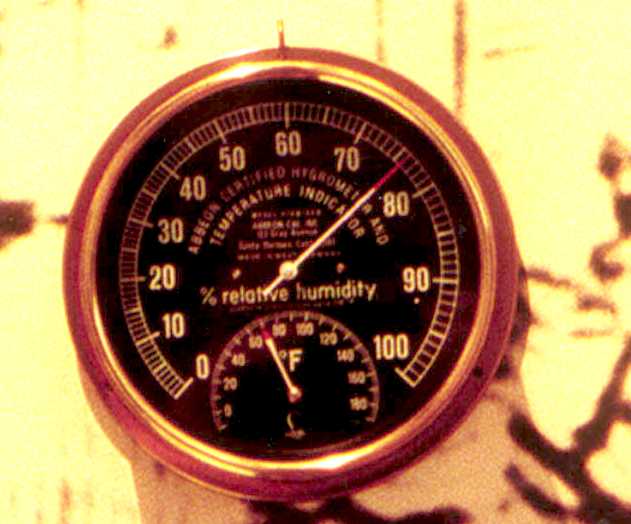 In
such cases, you must reduce the relative humidity levels before worrying about
any cleaning operations. Otherwise, the mold will return in short course. In
such cases, you must reduce the relative humidity levels before worrying about
any cleaning operations. Otherwise, the mold will return in short course.
Often this will mean that your institution will need to contract for temporary
dehumidification and cooling services and also that funds must be found for
improvements to the building HVAC system. This is expensive but its cost must
be compared to the value of your collection and your responsibility to safeguard
it.
Temporary Dehumidification Services
There are a number of companies that offer
temporary dehumidification services intended to quickly dry out buildings. How
quickly you dry the building and collections, of course, depends on the nature
of both. A preservation expert can help you determine this.
Most companies use desiccant dehumidification. There are several types, but all
can quickly reduce the relative humidity of a building to the 30% range by
removing large quantities of water from the air, the building materials, and
hygroscopic collections.
This process of dehumidification, however, will also increase the temperature
often by as much as 20 or 30° F. Such temperature increases can be devastating
for many collections, causing premature aging and deterioration. What this means
is that desiccant dehumidification must be coupled with cooling. Often this is
accomplished by what are called "in-line DX units." This means that cooling
units, operating off either electricity or chilled water, are placed in the same
air stream as the dehumidified air. This way, the air being circulated through
your building is not only at the appropriate humidity level (maybe 35% to 40%),
but it is also cooled to 65 to 70° F.
When you are contracting for temporary dehumidification, don't accept
contractors that provide you with "rules of thumb" or "guestimates" of how much
dehumidification you need. You are paying for an expensive service and you
should expect to receive detailed information. And you should examine bids on
the basis on installation cost, operating cost, demonstrated operational
reliability, and design assumptions.
Installation cost will include rental and set-up costs. It should include
not only the desiccant dehumidification, but also the cooling necessary to
maintain the appropriate set point temperature.
Operating cost should be calculated on the basis of prevailing energy
costs projected over the anticipated period of operation (which will be until
the building's system is adequate to provide appropriate levels of protection).
Demonstrated operational reliability should involve the contractor's
understanding of what your institution is seeking to accomplish, as well as an
understanding of equipment behavior in the specified application. In particular,
you should require some means of accountability, such as docking the contractor
for periods when the equipment fails to met the set point range.
Design assumptions can be quite complex far more complex than the brief
overview presented here. The design process itself involves four steps:
establish the set points and tolerances; calculate the heat and moisture loads;
select, size, and position the components; and select and locate controls. Of
these, the calculation of the moisture loads will likely be the most difficult,
since they will involve estimating the grains of water vapor per hour resulting
from such things as permeation, people, fresh air intake, and door activity.
Oversizing the equipment is likely to result in large fluctuations on a hourly
or daily basis which are inappropriate for library, museum, and archival
materials. The contractors should be asked to provide their design calculations
and the evaluation of these calculations by an outside expert should be a
criteria at least as important as price upon when institution selects a
contractor.
Cleaning
Up
Once mold appears people begin immediately
asking, "How do we kill it?" That's the
wrong question to ask.
In fact, be skeptical of anyone or any firm that suggests treatments based on
"disinfecting" for mold or totally eliminating it from your institution.
Remember, mold is everywhere and you can't totally eliminate it from museums,
libraries, and archives. That's why it is essential to control temperature and
relative humidity creating conditions that don't allow mold conidia to
transform into vegetative forms.
Remember also that even if you kill the mold (and the conidia are far harder to
kill than the vegetative stage), it is still respirable and still an allergen.
It can still have health consequences, even after it is dead.
So, what you need to do is clean it up not worry about killing it. This
means somehow physically removing it from collections, storage equipment, and
building fixtures. Once removed, if we pay attention to the building envelope,
ensure proper temperature and humidity levels, and provide adequate ventilation,
we shouldn't have any recurring problems.
You may occasionally see advice to use a wet-dry vacuum filled with water and a
chemical fungicide (or some special brand of water vacuum) to clean up mold. The
theory is that the liquid traps the mold and the conidia. This is bad advice.
These vacuums, whether brand name or put together in your shop, aren't very
effective at this task. They trap relatively little and allow a great deal to be
expelled. When they are used to vacuum mold, you create a bioaerosol that is
dispersed throughout the immediate area. Even if the chemical solution kills the
conidia, it is still dispersed, it is still respirable, and now it is also
coated with a toxic chemical.
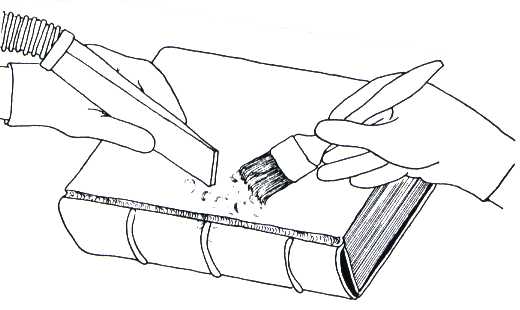 The
only vacuum appropriate for mold is a HEPA vac. Relatively small, light-weight
models are available for around $300 to $600. They can be used with soft brushes
to gather up mold on collections. Once vacuumed up, be sure to dispose of the
debris outdoors. The
only vacuum appropriate for mold is a HEPA vac. Relatively small, light-weight
models are available for around $300 to $600. They can be used with soft brushes
to gather up mold on collections. Once vacuumed up, be sure to dispose of the
debris outdoors.
HEPA respirators (identified as N95 or N100) may also be necessary when dealing
with mold you should consult your industrial hygienist. The common paper masks
with a single elastic band are unacceptable they offer a poor fit and don't
filter out mold particles. Even those respirators with NIOSH approval and two
elastic bands won't necessarily provide the protection you need.
Remember, also, that the use of respirators is governed by
OSHA's
Respiratory Protection Standard (29 CFR 1910.134). Failure to comply can
result in substantial fines. Furthermore, NIOSH has recently revised their
regulations for certifying air-purifying particulate respirators (42 CFR 84).
You should ensure that you are providing the training and protection required by
these laws.
If You
Hire Outside Contractors to Clean
Many institutions don't have the staff, don't
have the time, or don't want to deal with the health and safety issues involved
in cleaning up mold. They hire outside recovery firms to provide this service.
While this may be a good solution for your situation, be aware of the pit falls
(beyond the cost, which is likely to be high).
First of all, be aware that most recovery firms don't maintain full-time
cleaning staffs. They will bring in a supervisors and hire the rest of the
cleaning crew from the locally available labor pool. These individuals will have
had little or no exposure to your kinds of collections and will likely have no
commercial cleaning experience.
You need to ask recovery firms some tough questions: What will the ratio be of
full-time supervisors to labor pool employees? What kind of training program
will they provide prior to introducing these employees to your collection? What
is the level of their insurance and are their employees (including labor pool
employees) bonded? Are they providing the legally required levels of Workers
Compensation? And even if they are, what health and safety training do they
provide their temporary employees? What training, specific to your type of
collections, have their supervisors had?
You should also insist that they provide a demonstration of their cleaning
skills. This will provide you with an opportunity to examine how they handle
your collections and how they perform the cleaning operations.
Second, outside contractors may want to push the use of chemicals. Do not allow
them to use chemicals on collections or collection storage equipment. Insist on
HEPA vacuuming, or in the case of stubborn mold, perhaps the use of a dry
chemical sponge (if appropriate for the material).
And third, be very skeptical of firms that push duct cleaning. Remember, mold is
everywhere. You can't totally eliminate it. Even if the duct work itself has no
mold, fungal materials will still be quickly introduced back into the building
within days or weeks. The EPA has questioned the long-term impact of duct
cleaning. It may be better to spend your limited funds on improving temperature
and humidity controls than cleaning duct work. The only exception to this is if
the ducts are harboring dangerous molds and cleaning is recommended by your
industrial hygienist.
Cleaning
Various Materials
At times the mold will have left stains,
especially on textiles. There is very little you can do to remove these stains
yourself. Household bleaches are far too strong for most historic textiles.
Sometimes the stains can be removed by a textile conservator, but this is a very
complex procedure. The mold may also have grown down, into the substrate of your
collection. A conservator may also be able to remove this mold, but it will
require picking it out, strand-by-strand under magnification.
Removing mold from leather objects is equally difficult. Vacuuming is again the
best approach, but you must be careful not to press the nozzle of the vacuum
cleaner onto the object, or use its brush attachment with too much vigor. Either
may cause the mold to smear, staining the surface, or abrade the object. The
best approach is to hold the nozzle very close to the artifact, and allow the
suction to pull the mold off. You may use a moderately stiff hog hair or hake
hair brush to "sweep" the mold toward the nozzle. Be especially careful if there
are beadwork, delicate attachments, or loose fragments. You will want to cover
the nozzle with nylon mesh or use mesh over the object, to provide additional
protection.
If the mold has spread to painted or plaster walls and ceilings, they can be
either vacuumed or treated with a fungicide such as a solution of ū cup of
household bleach to 1 gallon of water. Of course, always wear rubber gloves and
protect your skin and eyes, as well as nearby surfaces. Begin at the bottom of
the wall and work up to the ceiling. Rinse well with clean water afterwards and
ensure the surfaces dry completely, using plenty of ventilation. In addition, do
not mix bleach with ammonia, or any other detergents or cleansers containing
ammonia. Mixed together the two are a lethal combination producing chlorine gas.
Many household cleaners contain ammonia, so be careful. In addition, consult an
architectural conservator before undertaking such cleaning on historic plaster
or paint (such as in a historic house museum).
For wood walls you may be able to clean mold off by using a mixture of 4 to 6
tablespoons of washing soda or trisodium phosphate to a gallon of water. Test in
an inconspicuous area first. If this is ineffective, try 4 to 6 tablespoons of
trisodium phosphate and 2 tablespoons of ammonia to a gallon of water. Do not
allow either solution to remain on the wood for more than a minute or so. Work
in small areas that can be rinsed and dried before moving on. Again, do not use
this cleaning approach on historic wood surfaces without consulting an
architectural or furniture conservator.
Modern carpet, a storehouse of not only moisture but also mold, should be
discarded, and replaced. Carpet cleaning techniques are generally not effective
on carpets with heavy mold levels.
Ceiling tiles are also good reservoirs of mold. Those stained with mold (even if
the tiles are dry) should be carefully removed, bagged, and discarded. New tiles
should be installed in their place. Do not attempt to clean or paint over the
mold it won't work.
For More
Information
If you would like more information about mold,
mold clean-ups, and water problems, check out these sources:
Environmental Protection Agency. 1991. Building Air Quality: A Guide for
Building Owners and Facility Managers. Washington, D.C.: Government Printing
Office.
Harriman, Lewis G., III, editor. 1990. The Dehumidification Handbook. Second
Edition. Amesbury, Maine: Munters Cargocaire.
Kowalski, W.K. and William Bahnfleth. 1998. Airborne Respiratory Diseases and
Mechanical Systems for Control of Microbes. Heating/Piping/Air-Conditioning.
July, pp. 34-48.
Singh, Jagjit, editor. 1994. Building Mycology. London: E & FN Spon.
Trechsel, Heinz R., editor. 1994. Moisture Control in Buildings. Philadelphia:
American Society for Testing and Materials.
A Couple
of On-Line Sources
There are a lot of on-line sources concerning
mold -- some good, some bad. Here are two that we believe are especially helpful
for museums, libraries, and archives.
The Canadian Conservation Institute's
Mould Outbreak:
An Immediate Response provides an excellent summary of mold remediation
efforts.
Indoor Mold: A General
Guide to Health Effects, Prevention, and Remediation is a detailed report prepared by the California
State Library's California Research Bureau that will answer many of your
questions concerning the health effects of mold. Note that it is a pdf file.
|